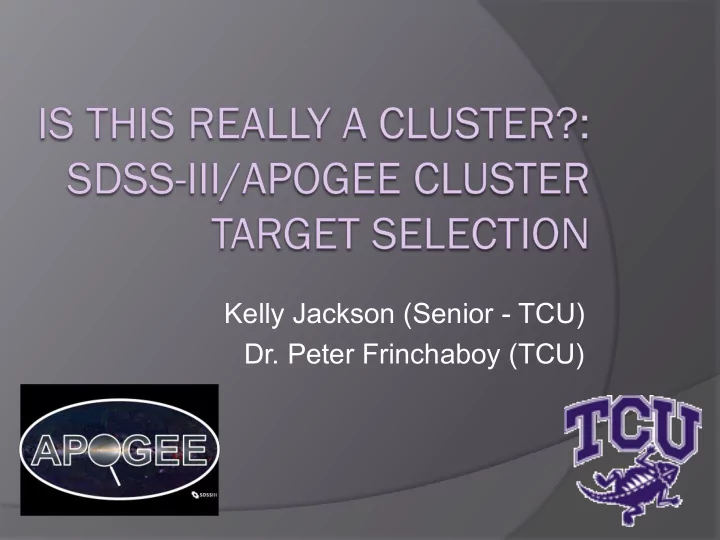

Kelly Jackson (Senior - TCU) Dr. Peter Frinchaboy (TCU)
Why star clusters? Open cluster - 100s to 1000s of stars that formed at the same time from the same cloud of interstellar gas and dust Stars have the same properties: age, distance from us, metallicity, and extinction value Extinction – dimming of starlight due to dust in ISM Star clusters are useful for studying stellar evolution and the cluster’s surrounding galaxy (e.g. the Milky Way)
Utilizing near to mid-infrared data collected from: Two Micron All-Sky Survey (2MASS) Spitzer Space Telescope / GLIMPSE-I, II, 3D, & 360 surveys Wide-Field Infrared Survey Explorer (WISE) 2MASS GLIMPSE 1.6 m 2.1 m 2.2 m 3.6 m 4.5 m
Areas within the Milky Way that have been covered by GLIMPSE surveys:
How to Isolate a Cluster Obtain extinction (A K ) values for each star in a cluster Raleigh Jeans Color Excess Method (Majewski, Zasowski, & Nidever 2011) Isolate area twice the cluster radius and compare stars within the cluster radius to outer “field stars”. Windows a range of A K and step through the A K values.
Compare normalized ratio of stars within cluster radius to background at each step through A K values Identify overdensity in A K space
Application to APOGEE - large-scale spectroscopic survey of Galactic stars. H -band (1.5-1.7μm), R ~ 25,000, σ RV ~ 300 m/s. 100,000 stars, S/N = 100/pixel, 15 elements/star. Will utilize star clusters in order to explore Galactic evolution Can directly link age and chemistry Isolated cluster members (especially red- giants) in targeted fields are submitted as high-priority targets.
Future Work Complications arise from wide range of cluster sizes and distances Problematic small, distant clusters and large, nearby clusters Need to determine what parameters work best for the majority of clusters Soon will utilize more WISE fields and UKIDSS to get deeper data
Acknowledgements We’d like to thank the following institutions for their support: Texas Space Grant Consortium NASA/JPL (60020, 61071, 61070, 61072) NSF REU grant (NSF 0851558) Texas Christian University, including a 2010 Science and Engineering Research Center (TCU-SERC) grant University of Texas at Austin for having us
Recommend
More recommend